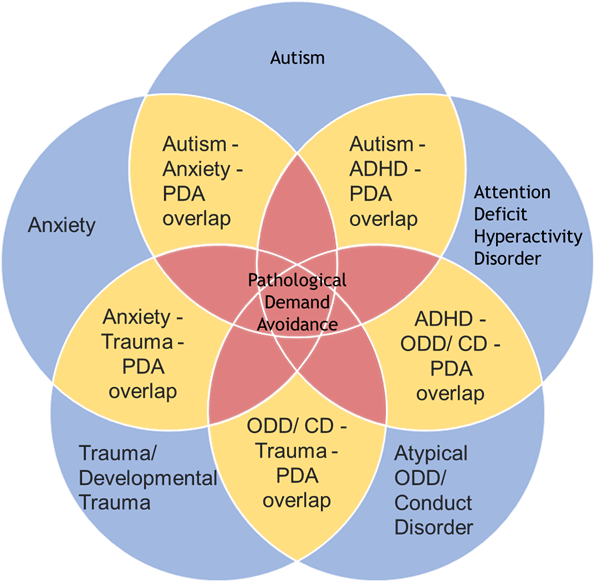
Pathological Demand Avoidance, often abbreviated as PDA, is a behavioral profile associated with apparently obsessive avoidance of everyday demands and expectations.
This condition, situated on the autism spectrum, is often characterized by an individual’s excessive resistance to ordinary demands, driven by high anxiety levels.
Understanding PDA, its causes, symptoms, and appropriate treatment methods can significantly contribute to effectively dealing with this condition, both among affected individuals and their caregivers.
Although PDA is less known compared to other conditions on the autism spectrum, it considerably impacts the people’s lives it touches, making the correct information about it crucial.
Unfortunately, misinformation and misunderstandings about PDA can further complicate interactions and exacerbate anxiety for individuals with PDA.
Thus, it is essential to provide accurate and accessible information insightful for parents, educators, practitioners, and individuals themselves.
PDA has unique traits that set it apart from other conditions, such as the characteristic pathological refusal, making it essential for it to be identified and handled accordingly.
The associated behaviors should not be misunderstood as disobedience or stubbornness, but rather a response to an internal struggle with complying with seemingly non-threatening demands.
Recognizing the critical importance of accurate information about PDA, this primer aims to delve into the distinct aspects of the condition.
The objective of this article is to present a comprehensive overview of PDA, exploring its causes, symptoms, and treatment alternatives available today.
With evidence-backed insights and expert opinions, the aim is to shed light on PDA, ultimately ensuring those affected are better understood, accepted, and supported.
Understanding PDA
Pathological Demand Avoidance, or PDA, as it’s commonly referred to, is a condition that lies on the autism spectrum.
Recognizing PDA and its unique characteristics is key for providing the most appropriate and effective support.
Definition of PDA
Origin and Recognition in Autistic Community
The concept of Pathological Demand Avoidance was first articulated by Newson in 1980, who observed key differences between classic autism or Asperger syndrome (no longer used or diagnosed) and children possessing PDA behavioral patterns.
It constitutes an entity within the Autistic Spectrum and is becoming increasingly accepted by the medical community, although not yet universally recognized.
The term “demand avoidance” results from the obsessive avoidance disorder of everyday demands manifested by an individual. Even simple, common expectations can trigger stress and anxiety, causing resistance.
Key Characteristics

PDA is defined by the resistance to everyday demands and expectations, related to high levels of anxiety.
People with PDA can often appear sociable and articulate but struggle with social identity and are subject to mood swings and impulsive behaviors.
The resistance can show itself in the form of negotiation, distraction, giving excuses, or, in more extreme cases, meltdowns.
Differentiating PDA from Other Autistic Experiences
While PDA is part of the autism spectrum, it differs from other autistic experiences by certain distinctive features.
Typically, people with PDA use social strategies as part of their avoidance, exhibit comfortability within role play and pretend play, and display obsessive behavior often focused on people.
These characteristics can often lead to a delayed diagnosis or misdiagnosis, which can result in inappropriate strategies being implemented that are likely to worsen the situation.
Misunderstandings about PDA
Common Misconceptions
Despite growing recognition, PDA remains misunderstood in many ways.
One common misconception is seeing the demand avoidance as deliberate defiance or non-compliance, whereas, in actuality, it is an anxiety response.
Another misconception is that individuals with PDA are simply trying to be controlling, which is far from the truth of their condition.
Effect of Misconceptions on Autistic Individuals with PDA
Misunderstandings about PDA can have harmful impacts on individuals with PDA and their families.
These inaccuracies can lead to feelings of isolation, frustration at lack of understanding, and inappropriate actions that add to anxiety rather than easing it.
Accurate understanding, on the other hand, can lead to strategies effective for managing the condition.
Variations in Individual Experiences
Like autism, PDA is a spectrum condition, leading to significant variations in experiences and presentations among individuals.
Some may mask symptoms in certain situations, exacerbating the difficulty in diagnosing PDA.
Diagnosis of PDA
Importance of Proper Assessment
While the path to PDA diagnosis is often fraught with obstacles, receiving a proper assessment is incredibly important.
Diagnosis facilitates access to tailored support and services, enhances understanding of one’s behavior, and delivers validation that individuals and their families may require.
Diagnostic Process
The diagnosis of PDA involves a detailed assessment process, which may include observations, school reports, family history, and structured interviews.
Parents and caregivers play a critical role in providing insights.
Challenges in Diagnosis
Diagnosing PDA poses unique challenges, chiefly due to the effective masking of traits and behaviors that individuals employ.
Furthermore, PDA’s overlap with other conditions can also lead to misdiagnosis or delayed diagnosis.
These challenges underscore the importance of clinicians who are trained and experienced with PDA to ensure that individuals receive support that truly addresses their needs.
Causes and Influences of PDA
Pathological Demand Avoidance, much like every aspect of the autism spectrum, is a complex neurodevelopmental condition shaped by various factors.
Let’s delve into the causes and influences that contribute to the development of PDA.
Current Understanding of Causes
Nature of Autistic Neurodivergency
The understanding of PDA’s causes starts by acknowledging the nature of autism as a neurodivergent condition.
Neurodivergence essentially refers to a variation from the typical neurodevelopmental trajectory, placing PDA within a spectrum of varied cognitive experiences.
Notably, PDA is not a result of upbringing or lifestyle choices but is rooted in the inherent wiring of the brain.
Genetic Factors
Research indicates that genetic factors likely play a significant role in the development of PDA.
Although no specific gene or set of genes has been directly linked to PDA, studies on families with autism spectrum disorders suggest a genetic component.
As with other aspects of the autism spectrum, PDA may involve multiple genes interacting in complex ways.
Environmental Considerations
Although genetics play an important role in the development of PDA, environmental factors also contribute.
Prenatal and perinatal factors, such as maternal stress, premature birth, and complications during delivery, may increase risk factors for neurodevelopmental disorders, including PDA.
However, more research is needed to fully understand these relationships.
Possible Influences on PDA Development
Early Childhood Factors
In many cases, PDA traits become evident during early childhood. Factors such as attachment styles, interactions with caregivers, and early experiences with social-emotional regulation might shape how PDA manifests.
By fostering supportive, understanding, and consistent environments, caregivers can help manage potential triggers, mitigating the impact of PDA, especially on child PDA behavior.
Personal Experiences and Coping Strategies
The quirks of individual experiences, including personal history, stressors, and interactions, can influence how PDA presents and how individuals cope with demands.
Given the pathological demand traits of this condition, strategies that foster a sense of control and limit exposure to stressful triggers can be beneficial for both children and adults with PDA.
Interactions within Society
Society and cultural contexts play a substantial role in shaping the experiences and perceptions of those with PDA.
Misconceptions about the condition, or a lack of understanding, can exacerbate stress and anxiety associated with PDA.
However, growing awareness, understanding, and acceptance of PDA and other forms of neurodiversity promote more inclusive and empathetic societal relationships.
Nuances in Research
Limitations of Current Studies
Current understanding of PDA is still evolving. Although research has come significantly forward in recent years, several limitations persist.
Many studies are small-scale, rely on parent-reported measures, or lack strictly controlled conditions.
Additionally, the very diversity and complexity of PDA pose substantial challenges to research.
Implication of Unresolved Questions
The unresolved questions and limitations in current knowledge about PDA underscore the need for further study in the field.
Increased understanding will aid in accurate PDA diagnosis, more effective PDA management strategies, improved societal acceptance, and more importantly, improved outcomes for those affected by Pathological Demand Avoidance.
Approaches and Strategies for Treatment
Navigating Pathological Demand Avoidance involves more than just understanding the condition’s traits and influences.
Developing a well-informed and compassionate approach towards treatment is key to improving quality of life and overall well-being for individuals with PDA.
Defining ‘Treatment’ in Autistic Context
Ethical Considerations in Treatment
In the context of Autistic Spectrum PDA, defining ‘treatment’ is a task that requires sensitivity and adherence to ethical considerations.
Given the nature of PDA as a neurodivergent condition rather than a disease, ‘treatment’ focuses less on trying to ‘cure’ or ‘remove’ the condition and more on strategies aimed at improving overall quality of life, reducing distress and promoting understanding.
Focus on Acceptance and Accommodation
Treatment strategies should strive towards acceptance and accommodation of PDA, rather than seeking to control or diminish it.
Understanding PDA means recognizing it as part of an individual’s character and experiences rather than a problem to be solved.
The goal should be to foster supportive environments that respect and adjust to the individual’s needs.
Avoidance of Pathologizing Language
Pathologizing language that treats PDA as an illness can create harmful stigmas and misconceptions.
Instead, it is more conducive to use neutral, respectful language that acknowledges the person’s experience and encourages acceptance and empathy.
Preferred Approach towards PDA
Role of Compassionate Understanding
In dealing with PDA, a compassionate understanding of the condition and its effects is paramount.
Recognizing PDA as a response to anxiety, rather than deliberate defiance, is crucial.
This perspective allows caregivers and professionals to view behaviors through a lens of empathy, leading to better patient-caregiver relationships, improved outcomes, and a more inclusive environment.
Importance of Personalized Strategies
Since PDA is a spectrum condition, there’s no one-size-fits-all solution to managing it.
Thus personalized strategies based on individual needs, preferences, and experiences are pivotal in managing PDA effectively, be it child PDA behavior or PDA in adults.
It’s essential for strategies to be flexible and adaptable given the nature of PDA.
Long-term Management
PDA management strategies should be designed with a long-term perspective.
Understanding the ebbs and flows of PDA, preparing for challenging periods, and having a proactive approach towards handling potential triggers can lead to sustainable and meaningful improvements over time.
Resources and Support for Autistic Individuals with PDA and Their Families
Therapy and Counseling Options
Professional help in the form of therapy and counseling can be extremely beneficial for individuals with PDA and their families.
Therapies focused on emotion regulation, anxiety management, and skills development, such as Somatic therapy, can provide practical tools for dealing with PDA.
Online and Community Support
Often, the journey with PDA can feel isolating. However, there is a wealth of online communities and resources that offer support, shared experiences, and practical advice.
Engaging with these communities can provide a sense of belonging and offer practical insights from those in similar situations.
Empowering Autistic Individuals with PDA
Finally, empowering Autistic individuals with PDA is at the heart of every support strategy.
This includes respecting their perspectives, promoting self-advocacy, and providing them with information and resources to understand their experiences better.
By doing so, individuals can better navigate their experiences with PDA and foster a sense of self-assurance and independence.
Reaffirming our Perspective on PDA
The discourse surrounding Pathological Demand Avoidance is one that is quickly evolving, and one that must remain rooted in the reality of those it affects.
It is of utmost importance to prioritize and amplify the voices of those situated within the Autistic Spectrum PDA.
Only by keeping these voices at the forefront can we truly begin to understand PDA and its effects.
These individuals are the true experts in their experience, and their input is invaluable in formulating strategies for acknowledgment, acceptance, and accommodation of PDA.
This inclusive perspective not only promotes greater empathy and understanding but also paves the way for more efficacious strategies to handle PDA.
From shaping more sensitive diagnostic processes to creating adaptable PDA management strategies, these insights guide the way.
By understanding the nature of PDA from those who live it, we foster environments that better support both individuals with PDA and those around them.
It is a reminder that, in our approach to PDA, the individual should always be more defining than the condition.
Familiarizing oneself with PDA does not end with reading an article or going through a few resources.
Like any other aspect of human diversity, understanding PDA is a commitment to continued learning, inquiry, and sensitivity towards experiences differing from our own.
As we grow in our understanding of neurodiversity, acknowledging and accommodating these behaviors should be a shared societal responsibility.
Fostering environments of acceptance will not only empower those with PDA but also enrich our collective experiences by embracing the full spectrum of human diversity.
It’s crucial to remember that at the heart of the discussion about PDA management strategies, and indeed, our understanding of PDA itself, are the individuals who navigate life with PDA – their experiences, their challenges, and their triumphs.
Their voices teach us the true essence of PDA, guiding us towards a society more supportive, understanding, and inclusive of all neurodivergent experiences.

